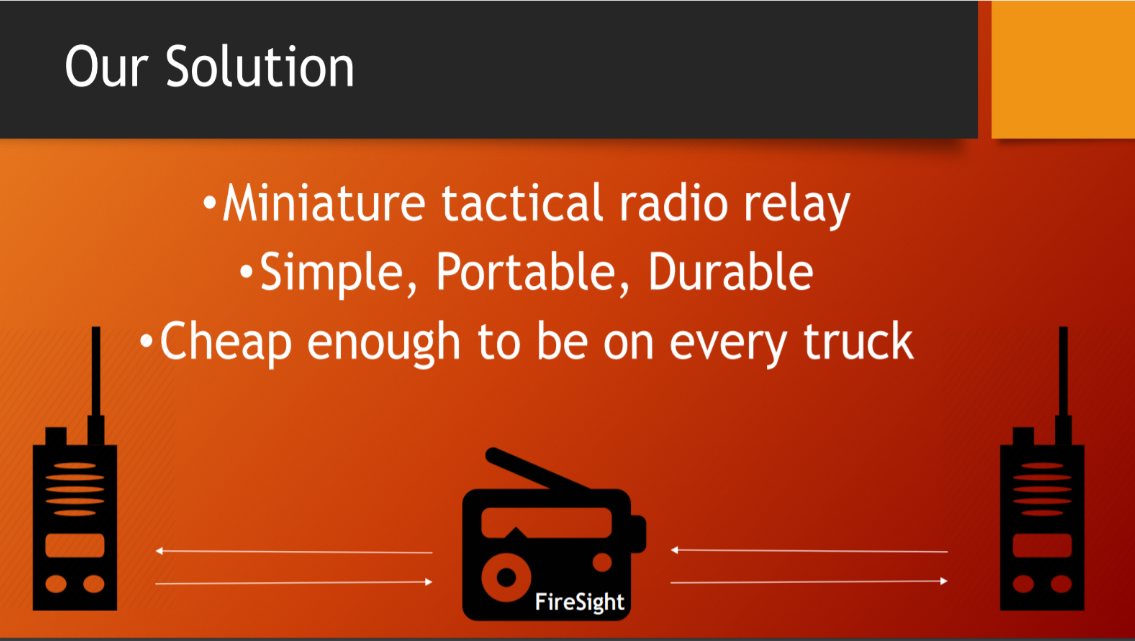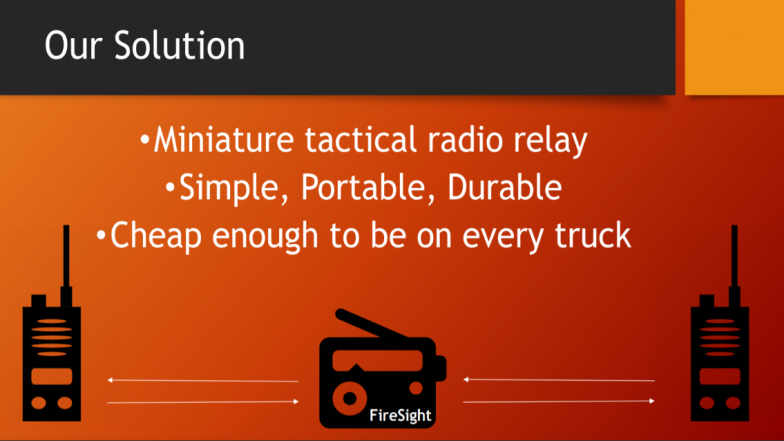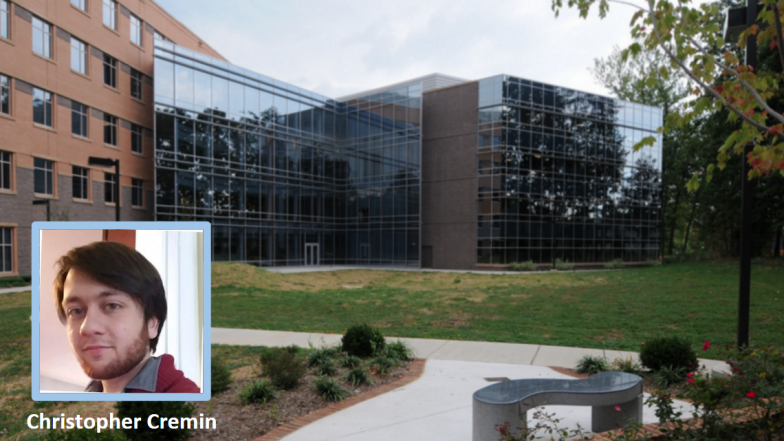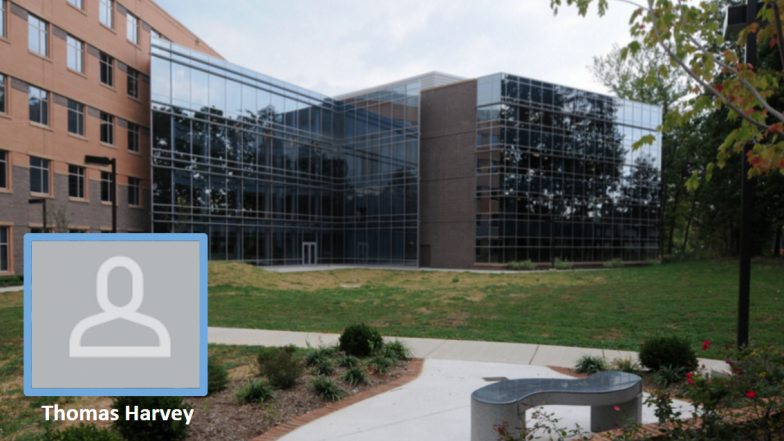Business Plan
Our Customers: The End Users
The average firefighter
- Mid-20s to early 30s
- Suburban to Urban department
- Trained to follow orders
Our Customer’s Problem
- Old concrete/steel buildings impede digital radio communication
- Firefighters are unable to receive orders Commanders are left in the dark
Current Alternatives
- Radio booster now in new building codes
- C-AT ICRI system on command vehicles
- Cumbersome, not always available
- “Talk-around” Channel
Our Solution
- Miniature tactical radio relay •Simple, Portable, Durable
- Cheap enough to be on every truck
Customer Benefits
- Less people waiting outside and
- More people fighting fire
Market Size
- NFPA figures, as of 2015: •29,727 departments and 58,750 stations
- In Northern VA: •Fairfax – 40 stations
- In Arlington – 10 stations
- In Loudoun – 25 stations
Business Model
Get:
Trade Shows
In-person
Demos
Word-of-mouth community
Keep:
Replacement of broken/lost units
Grow:
Updated equipment Future Products
“Go To Market”
Research and Development; Lab testing– August 2017
Safety Approval NIST, NIOSH; August 2018
Local department Partnering; August 2018
Attend Conferences– August 2019
Three-year Financials
Acquisition Costs:
Conferences – $800-$1200 for floor space,
$500-$1000 travel expenses
NIOSH approval – $850 per year
Pilot departments – $2500 per station
Lifetime value:
Asset Sale – $250 per unit – 10 per station; $2500 per station
At 20 stations per county – $50,000 potential per county
Roadmap for the next year
After R + D, find a pilot station
Dense Suburban county
We provide free equipment for testing
Test for NIOSH standards, approval
Approval process will take up the 1st year
Investor Pitch
Video
Lessons Learned
Business Canvas
Poster
Customer Interviews
Mark
Search and Rescue – Structure team, Fairfax County Fire and Rescue, Jefferson Fire Station
KEY INSIGHTS
There are many teams researching tools and techniques for improving firefighter/search and rescue team performance.
INTERVIEW DETAILS
When Mark came up to Tom and me, and after we had explained the purpose of our visit, he led us into the back office of the station, and spoke about the things he wanted to see out of a college student team. He began to show us scale models, made of balsa wood, of the Solid Sole Raker Shore – a structural support system used when a building is in danger of collapsing. He spoke from his experience being deployed with FEMA to Haiti, and gave several stories about setting up temporary equipment to stand in for collapsed infrastructure. He spoke about:
The radios they used as a stand-in where there were no cell towersthey relied mostly on their talkaround channel without any radio towers set up
the different building braces they set up when a structure could possibly collapsehe asked if we would be able to make a system to monitor when the structure they set up is under excess stress
He then told us about the research that he was aware was taking place:there are multiple studies on the way that concrete structures are destroyed. Both from the terrorism security angle and the angle of rescuing someone trapped under concrete
teams are looking for a way to “see” through concretee.g. small cameras they can feed through a 2″ hole, EM imaging, etc.
search and rescue teams are trying to find a way to detect if someone is pressed up against a slab of concrete before drilling any holes through.
Mark then invited me and Tom to come watch the teams train during their confined space drills, and see the kinds of conditions that they are expected to handle. On our way out, he gave us the contact information for Battalion Chief Glen Mason, recommending that we go speak to him about our project on radio communications
MUST HAVE
VP | Durability – able to operate with continuous abuse (Heat, Water, Impact)
VP | Reliable communication – prevents the radios from “bonking”
NICE TO HAVE
CS | FireFighters (Lieutenant and lower) in Urban departments
Larry
Search and Rescue – Confined Space team, Fairfax County Fire and Rescue, Jefferson Fire Station
KEY INSIGHTS
Simplicity is key – a system that takes 10 seconds to set up will get thrown out or left behind.
INTERVIEW DETAILS
We came to Jefferson Station with the intention of finding other features that firefighters would want in a system like ours, hoping to find an idea like Laura’s “radio door stop.” We were greeted in the front by a firefighter who did not give his name, but led us into the vehicle bay where several rescue personnel were practicing their knot-tying. The person who met us at the door went into the back of the station, and left us with Larry, a member of the Confined Spaces crew in the search and rescue team for the station. He introduced himself and his job, and asked about our class and our project. We told him that we were designing a portable radio relay, but that the intention of the course was to find out the issues that people like Larry have with the way they work now. This set the tone for the rest of the Firehouse visit, and led to the people in the station pitching new ideas to us that we could hold onto as avenues for growth. During the conversation, Larry told us about:
former students who came into the station with a concept for a system that would turn the sprinkler system in a building into a continuous radio antenna
the “big plastic box” he uses for tunnel rescue communicationssounded like an ICRI below-grade repeater – cable connected to a radio that hangs down into a tunnel/sewer
described it as “bulky” and “takes a while to set up”
Gave us the contact information for Shawn Fensterwale, the communications specialist at station 30, in Merrifield
Told us that stations 30 and 39 have the tunnel trucks that carry the radio boosting equipment and corded radios
Said “if [any equipment] doesn’t work the first time, I throw it out”there is no time during an incident/rescue to fiddle with technology
Because Larry was a member of the Confined Space rescue team, he found it important to integrate equipment into the SCBAwanted to slim down his suit, and especially wanted a radio that didn’t stick out from his body
The battery pack on his suit is the prime example of something that is too bulky for what it does: power the HUD in his helmet.
emphatically claimed that a new system needs to be wireless – it happens too often that his equipment gets snagged on the tunnel he’s crawling through.
After this, Mark, another rescue team member, came out and asked what we were talking about. He had spoken to students with several ideas before, and then he asked us to come into the office in the back of the station.
MUST HAVE
VP | Simplicity – equipment needs little to no training to use
VP | Size constraints – large enough to find, small enough to carry
NICE TO HAVE
CS | FireFighters (Lieutenant and lower) in Urban departments





